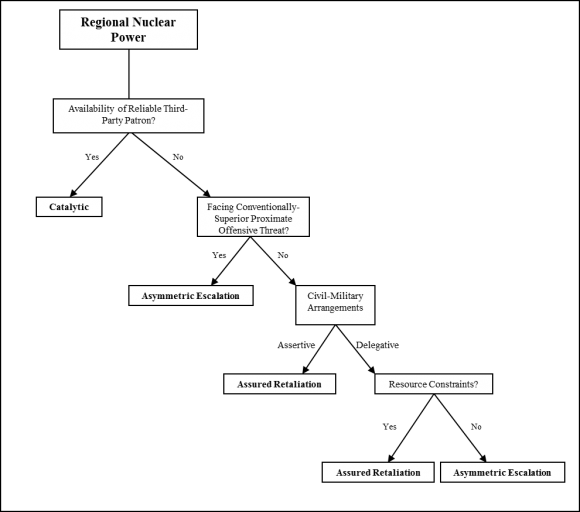Nuclear postures matter. They frame requirements, add to or detract from stability, and can affect outcomes when deterrence fails, which happens more than expected. Vipin Narang covers this ground in his masterful new book, Nuclear Strategy in the Modern Era: Regional Powers and International Conflict (2014). Finally, we have a book on proliferation that is rooted in the discipline of Political Science with persuasive explanatory powers and great analytical value. Vipin’s book has one chapter that only Political Scientists can relate to, but the rest is highly accessible.
Most of the deterrence literature spawned by the Cold War has little applicability to newer entrants into the nuclear club. For example, we can’t tell from this literature what nuclear posture newcomers will chose, and why. Vipin offers three basic choices: (1) assured retaliation; (2) catalytic (a posture designed to prompt the intervention of a patron); and (3) asymmetrical escalation. At present, India and China have adopted assured retaliation. South Africa, Israel, and Pakistan initially chose catalytic postures. France, and now Pakistan, adheres to asymmetrical escalation. Vipin concludes that an assured retaliation posture doesn’t fare well when paired up against asymmetrical escalation.
Nuclear postures aren’t immutable. He argues, quite cogently, that Pakistan switched from a catalytic to an asymmetric escalation posture after testing nuclear devices in 1998. He argues, less persuasively, that Israel switched from a catalytic to an assured destruction posture after the 1991 Gulf War. More on this later.
Why do countries choose one posture or another? Vipin argues that states optimize force structure and posture “for their external security and their internal threats and constraints.” Does the state have a reliable patron? If so, a catalytic posture might fit. Does it have assertive civil-military relations and confidence in its conventional capabilities? Then assured destruction is a good fit. Is a state disadvantaged conventionally and does its military hold sway? Then look for tactical nuclear weapons and asymmetric escalation. Here’s what the decision tree of Vipin’s “Posture Optimization Theory” looks like:

Vipin has persuaded me that his theory has stronger explanatory power than analytics grounded in realism, technological determinism, and strategic culture. His theory also does well in explaining when nuclear postures shift. His argument that, “If a state’s available options to augment deterrence through external balancing disappear and it faces extremely binding security constraints, a regional power has no option but to adopt an asymmetric escalation posture” fits Pakistan to a “T.” His characterizations of Indian, Chinese, French and South African nuclear postures are also quite good.
Israel is the outlying case, where Vipin’s theory falls short, as he readily acknowledges. He makes a convincing argument that Israel’s nuclear posture shifted away from catalytic after the 1991 Gulf war undermined assurance that Washington would intervene even more emphatically after Saddam Hussein’s Scud attacks. But shifted to what? Vipin’s typology suggests a shift to assured destruction, but this seems uncharacteristic of a nation that does not accept a mutual deterrence relationship with other states in the region.
All nuclear postures project mixed messages of catalytic, assured retaliation, and asymmetric escalation capabilities. Vipin maintains that “the primary envisioned employment of these three postures is mutually exclusive.” I’m not capable enough to parse Vipin’s coding methodology, but his analysis rings true, with the exception noted above.
Vipin’s analysis suggests that if Iran’s nuclear program is unconstrained, it could adopt either asymmetrical escalation or assured retaliation, depending on the state of civil-military-Revolutionary Guard interactions. As for the DPRK, Vipin’s typology suggests a catalytic posture as long as China is viewed as a reliable patron. If not, expect an asymmetric escalation posture.


Perhaps some of the reason that Israel’s nuclear posture is so opaque, aside from the fact that unlike every other Nuclear Weapons State they don’t talk about it, is because it is aimed in more than one direction. Israel seeks an asymmetric deterrence against regional foes, but also aims to preserve an independent mutually assured deterrent against Russia. I would agree there might have been a catalytic element before 1991 which diminished in importance thereafter.
Why not take the simplest explanation: nobody knows what Israel’s “posture” is because they don’t know either.
They’ve got nukes because they got nukes, and while they don’t know when or why they might wave ’em around, they’ll know it when they see it.
After all, their politics and their foreign policy is characterized by cynical opportunism. Why should this be any different?
I see any countries’ deterrent posture is categorized by first its economy and its ability to produce a massive arsenal and a triad. Nations that don’t have these resources produce smaller arsenals. Nations that also do not have large land masses are more limited in the number of weapons they can protect. Technology is a great determinant in the type of weapon systems that they can field. And nuclear response in any conflict cannot be determined. Countries have multiple options how they would respond to a conflict that does not so neatly fit into assured retaliation, catalytic, or asymmetric escalation. Any nuclear state could adopt any one of these postures depending on each particular situation.